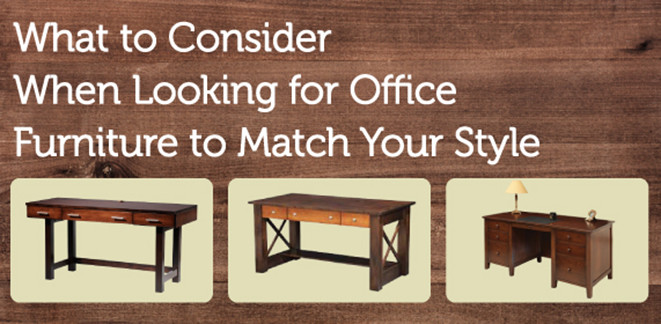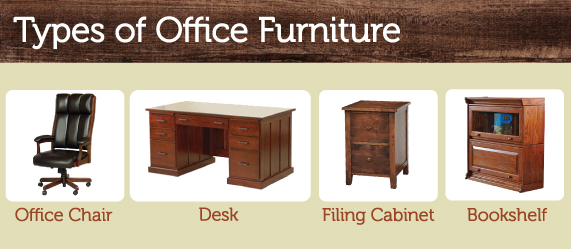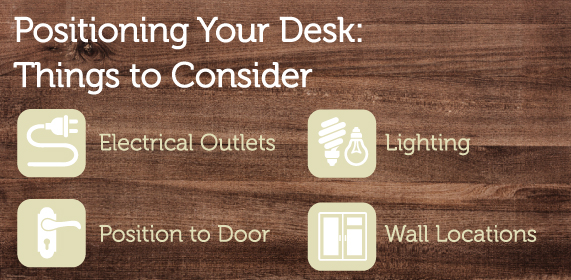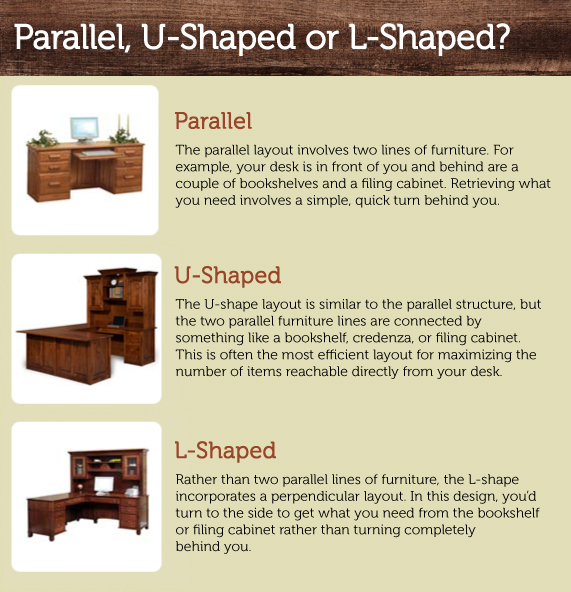What to Consider When Looking for Office Furniture to Match Your Style
In any office, whether it’s a corporate atmosphere or a designated area of your home, picking the right furniture is essential. Furniture must be functional and practical, yet comfortable and inviting to ensure productivity and ease.
Once you determine which furniture will best suit your needs, the layout of your office becomes critical. You want to ensure your furniture provides the most efficiency for completing daily tasks, but you also want to have a touch of style. Here are some tips to help you get started with office furniture.
Types of Office Furniture
There are a variety of office furniture options, but here are some of the most basic pieces that are useful in just about any office:
- Office chair – The office chair is probably one of the most obvious pieces of furniture in an office, and it’s not a piece to be taken lightly. This is one of the places you’ll be sitting for extensive periods of time, so it must be comfortable, offer support for the body and back, and have wheels to allow for easy movement. Adjustability is also an important consideration, because you want your office chair to accommodate factors such as your height and your desk height.
- Desk – Desks come in all shapes and sizes. Aside from budget, you should also consider the desk’s size. Will it offer enough space for necessary items like a computer and a stapler? Will it take up the majority of the room, and will it provide enough storage?A desk with a hutch or drawers is one way to ensure your office furniture has lots of storage. There are also sleeker options that might be more streamlined, but you may need supplemental storage options. Desks are also composed of a variety of materials – a solid wood design often adds an element of elegance to your space.
- Filing cabinet – While you may not have the reams of documents you stored in the past, you most likely have some documents that are better stashed away in an organized fashion. Depending on your profession, filing cabinets are a convenient way to store documents, and depending on their design, they can also enhance your office atmosphere. When choosing a filing cabinet, consider the following:
- How often will you be accessing necessary files?
- What’s the size of the files you need to store?
- What material do you need the filing cabinet to be composed of – wood, metal, or something that’s fireproof?
- Does it need to be able to be locked?
- Bookshelf – Books are a part of everyday life. Despite the number of books that can be found electronically, sometimes having the hard copy is easier or more enjoyable. Bookshelves are an authentic way to display and organize books, supplies, and items like pictures or memorabilia. A well-organized bookshelf can also add some sophistication to your office design.
What to Consider
As with any furniture investment, office furniture comes with multiple decisions. Before you decide to buy a piece of consider, think about:
- The space you’re furnishing -Will you be buying furniture for a corporate office or the back room of a retail shop? What if you’re simply purchasing furniture for your home office and you’re likely the only person who will see it? If you’re buying furniture for a corporate office, you might want it to look sophisticated and modern. For a home office, comfortable and homey may be the vibes you’re targeting. For either of these scenarios, solid wood office furniture may be attractive options.
- Budget – Money is one of the biggest decision-making factors in life, and office design is no exception. Budget is a crucial element when deciding on which office furniture to purchase. In a small start-up, you probably don’t want the majority of your initial costs to be the furniture. However, you probably don’t want to replace all your furniture in one or two years, either.To effectively develop a budget, start with a plan. How many of each item do you need? When looking for home office furniture, three office chairs probably won’t be necessary but you might need three bookshelves. Once you’ve established your needs, shop for office furniture online to compare prices and find items that will last well into the future.
- Durability – No matter how careful we are, furniture can easily take a beating. How well it will hold up with constant use is important. Plastic tables or desks may be easy to move around and may be great as a temporary solution. But after being used by many different people, parts can break, the surface may become scratched, or it could give out altogether. Solid wood office furniture, on the other hand, can survive many years, many employees, and maybe even some scratches – while still holding up and providing comfort to your office space.
- Functionality – We not only want office furniture to be beautiful and durable, but we also want it to be functional. A small corner desk may look great, but if a large desktop computer takes up the entire surface, it’s probably not practical. For a piece of furniture to be functional, it must allow you to perform your office tasks with ease and comfort.
- Size of the furniture and your space – When designing any office space, the size of the furniture is critical. If you need office furniture for small spaces, a large, oversized desk won’t be the best option. You’ll likely want something that is a bit smaller and perhaps more streamlined. If you need a bookshelf, office chair, desk, and filing cabinet, you’ll want to ensure there is enough space for all of it without the area becoming cluttered or difficult to move around.
- Storage – No matter how digital we get, we still have stuff that needs to be stored. We’ll need easy access to certain items, but other items like extra copy paper need to be stowed away for future use. Should you opt for a desk with drawers, or will an extra bookshelf suffice? Consider how concealed you’d like your items to be, and go from there. If you’re choosing office furniture with lots of storage, consider the following:
- Style – To enhance the look of the office atmosphere, furniture pieces should coordinate and complement one other.
- The frequency you’ll be accessing the materials This may help you determine if you’ll need something with open storage, or a piece that can be closed.
- Location – Placing the furniture in prime locations will ensure your items are readily available, so you don’t waste any time searching for them.
- Tone and style of the furniture – The tone of your furniture is closely aligned with the type of space you’ll be furnishing. In a home office, an oversized wood desk can be sophisticated and comfortable. For a corporate office, solid wood office furniture is still a viable option, but sleeker designs might be more ideal.
Tips for Arranging Your Furniture
Once you decide on the furniture to purchase, it’s time for the next step: how to arrange your office. You’ll find dozens of tips out there, but the most important aspect is finding the arrangement that works for you.
Consider the Size of your Space
In many cases, your office might be small. It could be the room in the house too small for a guest bedroom or a tucked-away storage area. If the furniture you purchase is too large, you might end up with a crowded space or you might not have enough room for all your furniture.
One way to help avoid this common pitfall is to measure. Measure the size of your room, and once you begin the hunt for furniture, measure the pieces you’re considering as well. Once you have all the measurements, you can use them to map out your space. Draw it up on a piece of paper and try setting up different arrangements. Not only will you have a rough idea of how your space will look, but you could also avoid having to rearrange several times once your furniture arrives.
If your space is small, you’ll want to find office furniture for small spaces. Often, these furniture designs can be stacked on one another, such as a desk with a hutch. A hutch provides extra storage and doesn’t take up potentially limited floor space.
You’ll also need to ensure you can navigate around your office without bumping into furniture or having to squeeze through small openings between pieces.
Consider the Items You Use Most
How many times per day do you get into the filing cabinet or use the printer? Do you constantly need a stapler or tape? When you’re laying out your office, efficiency should be top priority. While regular movement is good for our health, when you have a huge to-do list looming, you probably don’t want to be getting up every two minutes to retrieve something from the printer.
If a printer, for instance, is a device you have a close relationship with, you might want to choose a large desk that is large enough to keep your printer right by your computer. Or you may want to have a bookshelf or a filing cabinet close by where your printer can sit.
Decide on the Position of Your Desk
Since your desk is the focal point and one of the most used pieces of furniture in your entire office, start by deciding on the best place for it. Consider the:
- Locations of electrical outlets – Your desk will probably be the location where most of your electronic devices will be housed, so you’ll want to make sure it’s close to power sources. This will help increase efficiency and also decrease the likelihood of someone tripping over a cord.
- Position in relation to the door – Consider which direction your door opens. If it swings inward, you’ll want to ensure there is enough room for the door to open completely, without hitting your desk. You’ll also want enough space for people to be able to enter the office without feeling like you’re being bombarded.You might also want to arrange your desk to avoid having a direct view outside your door. This can lead to more distractions.
- Windows and lighting – Natural light is often ideal, so place your desk near a window if you enjoy the light. Morning, mid-day or afternoon sun, however, can create glare on items like a computer, so shades or additional lighting may also be needed.
- Location of the walls – When you have a view of a wall directly in front of you, it can curb your creativity and productivity. If possible, try to make sure there is some space between you and the wall. You can even set a bookshelf or a filing cabinet behind you and have your desk in front, so you can view the rest of your office instead of only the wall.If you don’t have other option for your space, consider painting the wall in a color that makes you feel relaxed or hang one of your favorite pictures.
Parallel, U-Shaped, or L-Shaped Arrangements?
Once you determine where your desk will be most efficient, you can plan the arrangement of the rest of the furniture, keeping in mind the items you’ll need most. Three typical layouts include:
Cut the Clutter
Clutter in any space, but especially an office, can create stress. Sometimes, even though items may be organized, the space can still seem cluttered if there are too many out in the open. If you have a closet or storage space that can be closed off, it might be ideal for materials you don’t use regularly. Bins on a bookshelf may also help to organize infrequently used items.
Only keep the items you need to do your job in your office space. If something is in the way or detracts from your productivity, it belongs in another area. Clutter also applies to the furniture itself. If you have too many pieces, or overly large furniture in a small space, the layout can appear jumbled and disorganized.
Choose Lighting That Increases Productivity
Natural light is ideal in an office as it can boost mood and productivity while reducing fatigue and eye strain. If natural light isn’t an option, opt for soft lighting from table and floor lamps rather than the harshness of most large fluorescent lights.
You’ll also want to ensure you have task lighting. If you regularly file papers, you might want to have a lamp near the filing cabinet so you can easily read file labels.
Make sure lighting is positioned in a way that doesn’t cast irritating shadows. If you’re right-handed, consider placing a desk lamp on the left side of your desk so your hand doesn’t create a shadow when you’re writing. You’ll also want to avoid placing lights where they will cause glare on items like the computer screen.
Once you’ve selected your furniture and arranged it in a stylish, efficient way, you can relax and enjoy your productive workspace. If you need assistance and ideas for solid wood office furniture, AmishOutletStore.com can help. Sign up for our newsletter to receive more tips, or contact our team today!
















 Are you a visual person? Check out our video to see how easy our process is!
Are you a visual person? Check out our video to see how easy our process is!